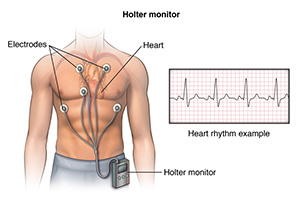Holter Monitoring

Definition
Holter monitoring is a continuous recording of your ECG, usually for 24 or 48 hours, while you go about your usual daily activities. It is especially useful in diagnosing abnormal heart rhythms. The Holter monitor itself is a small, portable cassette recorder. Several electrodes (small sticky patches) are placed on your chest and connected by wires to the recorder.
Purpose
- To detect abnormal heart rhythms that may now occur during a standard ECG test.
- To assess recurring symptoms such as dizziness, fainting, and palpitations.
- To evaluate the effectiveness of treatments, such as medications and pacemakers, that help control abnormal heart rhythms.
Before The Test
- Wear a loose fitting blouse or shirt, with the buttons in the front.
- Do not use lotions or bath oil on your skin. This will prevent the electrodes from sticking on your skin for 24 / 48 hours.
- There are no dietary restrictions.
- Ask your physician if you are to take your medication as ordered.
During The Test
- Several areas on your chest will be cleansed with alcohol and an abrasive pad, to ensure good electrode contact. Men may need to have areas of their chest shaved.
- Please inform the medical assistant or nurse if you are allergic to cloth or paper tape. This will be used to help secure the electrodes on your skin.
- The electrodes are connected by wires to the recorder. The nurse or medical assistant will check the system to make sure it is working properly.
- You can do anything you would normally do, except take a bath or shower while the monitor is on. Do not get the electrodes, wires, or recorder wet.
- Try to sleep on your back, with the recorder positioned at your side so that the electrodes are not pulled off.
- You will keep a diary (or log) in which you enter your activities, any symptoms you experience, and the time at which the symptoms occurred. The diary is very important, because it enables the doctor to correlate your activities and symptoms with the ECG tracing. You will need to note down your bed and wake time as your heart rate decreases while you are sleeping. DON’T FORGET TO BRING THE DIARY BACK WHEN YOU RETURN THE RECORDER!
After The Test
- Once you return the monitor, the cassette is analyzed by a computer, and scanned by a technician. The report is printed for the doctor to review.
- The information gained will help your doctor make an accurate diagnosis and develop a treatment plan for you. A full report will be sent to your referring physician.
